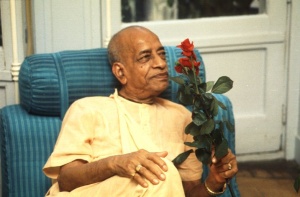CC Madhya 20.165 (1975): Difference between revisions
(Vanibot #0027: CCMirror - Mirror CC's 1996 edition to form a basis for 1975) |
(Vanibot #0020: VersionCompareLinker - added a link to the Version Compare feature) |
||
| Line 2: | Line 2: | ||
<div style="float:left">'''[[Sri Caitanya-caritamrta (1975)|Śrī Caitanya-caritāmṛta (1975)]] - [[CC Madhya (1975)|Madhya-līlā]] - [[CC Madhya 20 (1975)|Chapter 20: Lord Śrī Caitanya Mahāprabhu Instructs Sanātana Gosvāmī in the Science of the Absolute Truth]]'''</div> | <div style="float:left">'''[[Sri Caitanya-caritamrta (1975)|Śrī Caitanya-caritāmṛta (1975)]] - [[CC Madhya (1975)|Madhya-līlā]] - [[CC Madhya 20 (1975)|Chapter 20: Lord Śrī Caitanya Mahāprabhu Instructs Sanātana Gosvāmī in the Science of the Absolute Truth]]'''</div> | ||
<div style="float:right">[[File:Go-previous.png|link=CC Madhya 20.164 (1975)|Madhya-līlā 20.164]] '''[[CC Madhya 20.164 (1975)|Madhya-līlā 20.164]] - [[CC Madhya 20.166 (1975)|Madhya-līlā 20.166]]''' [[File:Go-next.png|link=CC Madhya 20.166 (1975)|Madhya-līlā 20.166]]</div> | <div style="float:right">[[File:Go-previous.png|link=CC Madhya 20.164 (1975)|Madhya-līlā 20.164]] '''[[CC Madhya 20.164 (1975)|Madhya-līlā 20.164]] - [[CC Madhya 20.166 (1975)|Madhya-līlā 20.166]]''' [[File:Go-next.png|link=CC Madhya 20.166 (1975)|Madhya-līlā 20.166]]</div> | ||
{{CompareVersions|CC|Madhya 20.165|CC 1975|CC 1996}} | |||
{{RandomImage}} | {{RandomImage}} | ||
==== TEXT 165 ==== | ==== TEXT 165 ==== | ||
<div class="verse"> | <div class="verse"> | ||
: | :sva yaṁ-rūpa, tad-ekātma-rūpa, āveśa--nāma | ||
:prathamei tina-rūpe rahena bhagavān | :prathamei tina-rūpe rahena bhagavān | ||
</div> | </div> | ||
| Line 18: | Line 17: | ||
<div class="synonyms"> | <div class="synonyms"> | ||
sva yam-rūpa—the personal form; tat-ekātma-rūpa—the same form, nondifferent from svayaṁ-rūpa; āveśa—especially empowered; nāma—named; prathamei—in the beginning; tina-rūpe—in three forms; rahena—remains; bhagavān—the Supreme Personality of Godhead. | |||
</div> | </div> | ||
| Line 25: | Line 24: | ||
<div class="translation"> | <div class="translation"> | ||
"The Supreme Personality of Godhead exists in three principal forms-svayaṁ-rūpa, tad-ekātma-rūpa, and āveśa-rūpa. | |||
</div> | </div> | ||
| Line 32: | Line 31: | ||
<div class="purport"> | <div class="purport"> | ||
Śrīla Rūpa Gosvāmī has described | Śrīla Rūpa Gosvāmī has described svayaṁ-rūpa in his Laghu-bhāgavatāmṛta, pūrva-khaṇḍa, verse 12, ananyāpekṣi yad rūpaṁ svayaṁ-rūpaḥ sa ucyate: the original form of the Supreme Personality of Godhead does not depend on other forms. The original form is called svayaṁ-rūpa, and it is described in Śrīmad-Bhāgavatam: kṛṣṇas tu bhagavān svayam ([[SB 1.3.28|1.3.28]]). Kṛṣṇa's original form as a cowherd boy in Vṛndāvana is called svayaṁ-rūpa. It is confirmed in the Brahma-saṁhitā (5.1): | ||
:īśvaraḥ paramaḥ kṛṣṇaḥ | |||
sac-cid-ānanda-vigrahaḥ | |||
:anādir ādir govindaḥ | |||
sarva-kāraṇa-kāraṇam | |||
There is nothing superior to Govinda. He is the ultimate source and the cause of all causes. In Bhagavad-gītā ([[BG 7.7 (1972)|7.7]]) the Lord says, mattaḥ parataraṁ nānyat: "There is no truth superior to Me. | |||
The tad-ekātma-rūpa is also described in the Laghu-bhāgavatāmṛta, Pūrva-khaṇḍa, verse 14: | |||
: | |||
:yad rūpaṁ tad-abhedena | |||
:svarūpeṇa virājate | |||
:ākṛtyādibhir anyādṛk | |||
:sa tad-ekātma-rūpakaḥ | |||
The tad-ekātma-rūpa forms exist simultaneously with the svayaṁ-rūpa form and are nondifferent. At the same time, the bodily features and specific activities appear to be different. This tad-ekātma-rūpa is also divided into two categories-svāṁśa and vilāsa. | |||
His āveśa form is also explained in the Laghu-bhāgavatāmṛta, verse 18: | |||
jñāna-śaktyādi-kalayā | |||
:ta āveśā nigadyante jīvā eva mahattamāḥ | :yatrāviṣṭo janārdanaḥ | ||
:ta āveśā nigadyante | |||
:jīvā eva mahattamāḥ | |||
A living entity who is specifically empowered by the Lord with knowledge or strength is technically called āveśa-rūpa. As stated in the Caitanya-caritāmṛta ([[CC Antya 7.11 (1975)|Antya 7.11]]), kṛṣṇa-śakti vinā nahe tāra pravartana: unless a devotee is specifically empowered by the Lord, he cannot preach the holy name of the Lord all over the world. This is an explanation of the word āveśa-rūpa. | |||
</div> | </div> | ||
Latest revision as of 12:46, 27 January 2020

A.C. Bhaktivedanta Swami Prabhupada
TEXT 165
- sva yaṁ-rūpa, tad-ekātma-rūpa, āveśa--nāma
- prathamei tina-rūpe rahena bhagavān
SYNONYMS
sva yam-rūpa—the personal form; tat-ekātma-rūpa—the same form, nondifferent from svayaṁ-rūpa; āveśa—especially empowered; nāma—named; prathamei—in the beginning; tina-rūpe—in three forms; rahena—remains; bhagavān—the Supreme Personality of Godhead.
TRANSLATION
"The Supreme Personality of Godhead exists in three principal forms-svayaṁ-rūpa, tad-ekātma-rūpa, and āveśa-rūpa.
PURPORT
Śrīla Rūpa Gosvāmī has described svayaṁ-rūpa in his Laghu-bhāgavatāmṛta, pūrva-khaṇḍa, verse 12, ananyāpekṣi yad rūpaṁ svayaṁ-rūpaḥ sa ucyate: the original form of the Supreme Personality of Godhead does not depend on other forms. The original form is called svayaṁ-rūpa, and it is described in Śrīmad-Bhāgavatam: kṛṣṇas tu bhagavān svayam (1.3.28). Kṛṣṇa's original form as a cowherd boy in Vṛndāvana is called svayaṁ-rūpa. It is confirmed in the Brahma-saṁhitā (5.1):
- īśvaraḥ paramaḥ kṛṣṇaḥ
sac-cid-ānanda-vigrahaḥ
- anādir ādir govindaḥ
sarva-kāraṇa-kāraṇam
There is nothing superior to Govinda. He is the ultimate source and the cause of all causes. In Bhagavad-gītā (7.7) the Lord says, mattaḥ parataraṁ nānyat: "There is no truth superior to Me.
The tad-ekātma-rūpa is also described in the Laghu-bhāgavatāmṛta, Pūrva-khaṇḍa, verse 14:
- yad rūpaṁ tad-abhedena
- svarūpeṇa virājate
- ākṛtyādibhir anyādṛk
- sa tad-ekātma-rūpakaḥ
The tad-ekātma-rūpa forms exist simultaneously with the svayaṁ-rūpa form and are nondifferent. At the same time, the bodily features and specific activities appear to be different. This tad-ekātma-rūpa is also divided into two categories-svāṁśa and vilāsa.
His āveśa form is also explained in the Laghu-bhāgavatāmṛta, verse 18:
jñāna-śaktyādi-kalayā
- yatrāviṣṭo janārdanaḥ
- ta āveśā nigadyante
- jīvā eva mahattamāḥ
A living entity who is specifically empowered by the Lord with knowledge or strength is technically called āveśa-rūpa. As stated in the Caitanya-caritāmṛta (Antya 7.11), kṛṣṇa-śakti vinā nahe tāra pravartana: unless a devotee is specifically empowered by the Lord, he cannot preach the holy name of the Lord all over the world. This is an explanation of the word āveśa-rūpa.